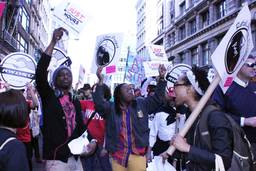We must consider how a new generation of unions can become relevant in a transformed economy.
Every Labor Day, we hear about the landmark achievements of working people and their unions. Advocates of the past successfully worked to prohibit child labor and to create the 40-hour workweek. They closed sweatshops and ended systems of industrial homework, in which factory employees were made to do labor-intensive tasks for businesses late at night and in their own homes.
These achievements were indeed historic. At the same time, one wonders if these hard-fought rights are still meaningful for American workers today. In our global economy, many of us bring our work home with us, few enjoy an eight-hour workday, and everyone is forced to compete with sweatshops and child labor in far corners of the world.
This year, when so many Americans are struggling just to get by – rather than working to make a decent living – we must rethink what type of labor institutions are needed to restore and protect workers rights and make work pay again.
Since the 19th century, our economy has cycled through a radical transformation every fifty to seventy-five years. Just as America went from having an agrarian economy to an industrial one in the late 1800s and early 1900s, we have more recently shifted into an information economy. During every period of transition, many people get left behind and our democracy feels the strain of growing inequality. Too often, the insecurity and resentment fostered by rapid structural change provokes harmful waves of scapegoating and anti-immigrant nativism.
It takes the organized efforts of working people to reverse these trends toward exclusion and to ensure that each new epoch will bring a shared prosperity. During the transition to the industrial economy, it was not preordained that the auto, steel, or textile industries would provide living wages, health care, pensions, and other benefits that allowed for a stable, thriving middle class in this country. Rather, employees needed to use the institution of collective bargaining to come together, negotiate with their employers, and demand the conditions that would provide a healthy quality of life for working people.
Today, in the wake of an economic crisis that has left American workers more insecure than ever, we need to move our nation’s labor laws out of the industrial era and into the new economy. American labor law is still based in the National Labor Relations Act, passed in 1930s. It was designed with the employment relationships of those bygone times in mind. Today, even in a bad economy, most people don’t see unions as the solution to their woes. That’s because current unions are structured to represent employees in traditional workplaces that are steadily disappearing.
In the fast-growing service sectors of the economy, new work arrangements are the norm. From accountants and software developers to technical writers and quality assurance workers, individuals who might once have been permanent employees of a single company are now independent contractors, working on a contingent basis for a variety of corporations. Even in blue-collar fields, employees are increasingly hired on a part-time or temporary basis. They are often outsourced and subcontracted. And they move regularly from one employer to another.
These people all have an interest in organizing with their co-workers to better the conditions of their employment. But they do not fit within the structure of yesterday’s unions.
Given these profound shifts, labor laws must be changed to recognize the rights of new types of workers. And it must allow them to form the next generation of labor organizations.
Labor has always been structured in direct relation to capital. In the nineteenth century, skilled trade workers formed craft unions and professional guilds, building organizations like the Knights of Labor. In the twentieth century, as large corporations emerged, employees organized themselves across industries and formed national and international unions to match the scale of business.
In our flexible economy, people once again identify more with their profession than with a single employer. For them to come together, we need to revise the rules around freedom of association and allow contemporary workers to form organizations that are a hybrid between older industrial unions and modern professional associations.
Getting there requires the labor movement to use its political capital to demand a legal framework for collective bargaining that will allow it to push beyond its traditional boundaries. This means spending as much time advocating for the rights of those currently excluded from its ranks as it spends protecting existing union members. Moreover, elected officials must enact substantive reforms that will allow labor organizations to change with the times.
The alternative is dire. The longer we neglect the yawning gulf between the structure of our economy and the structure of our labor laws, the faster shared prosperity and a secure middle class in America will become relics of the past.
This article originally appeared at the Huffington Post. Amy Dean’s website is here.








